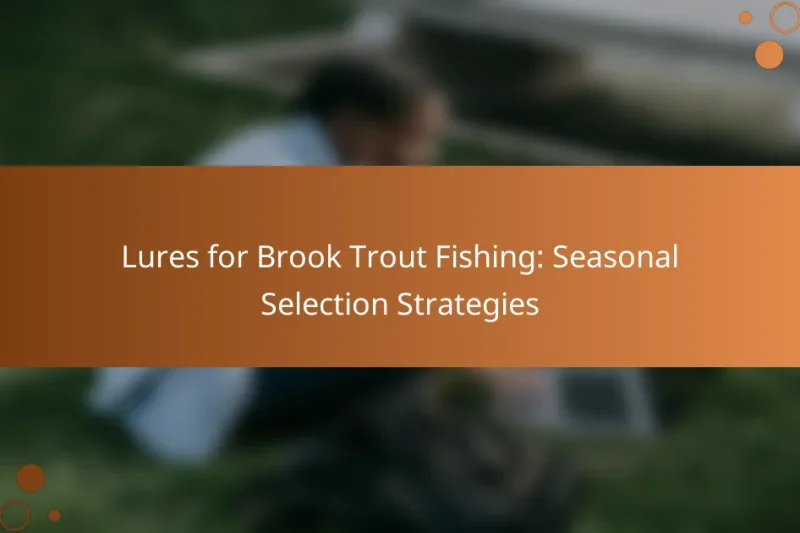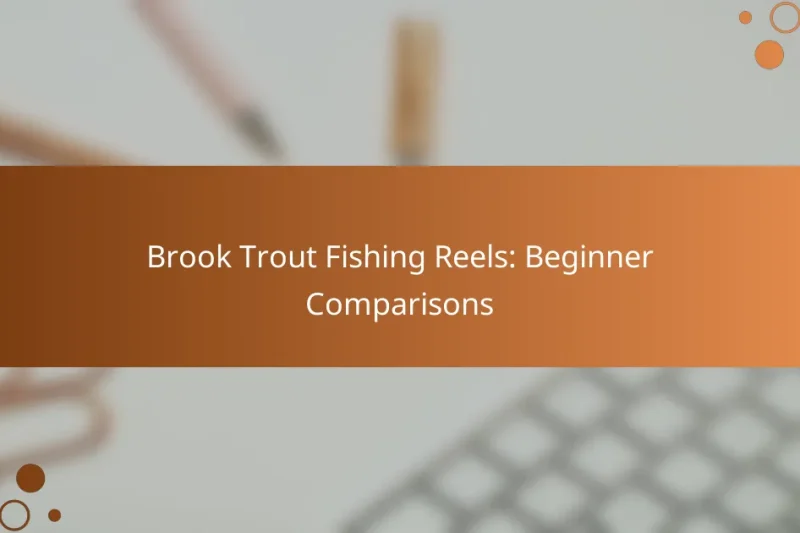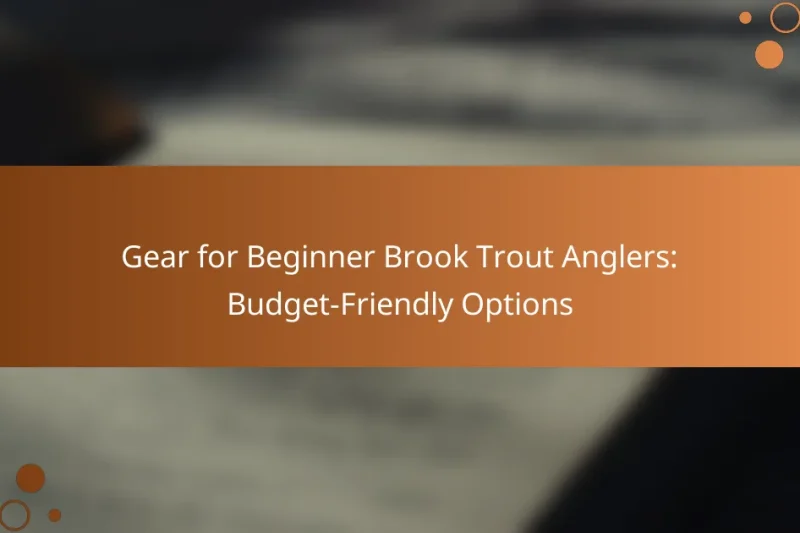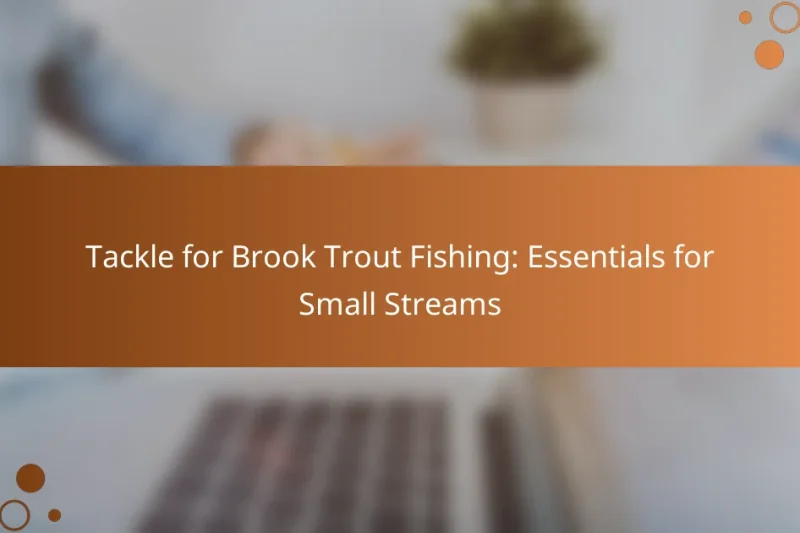Brook trout fishing requires a strategic approach to lure selection based on the season. In spring, … Lures for Brook Trout Fishing: Seasonal Selection StrategiesRead more
Best Gear for Brook Trout
When targeting brook trout, having the right gear is essential for a successful fishing experience. Lightweight spinning rods, ultralight reels, and fluorocarbon fishing line are key components that enhance your ability to navigate the streams and rivers where these fish thrive. Brands like Shimano, St. Croix, Orvis, and Rapala offer high-quality equipment tailored specifically for brook trout fishing, ensuring you have the best tools at your disposal.
Line for Brook Trout Fishing: Monofilament and Fluorocarbon
When it comes to brook trout fishing, selecting the right line is crucial for success, with … Line for Brook Trout Fishing: Monofilament and FluorocarbonRead more
Waders for Brook Trout Fishing: Best Options for Cold Water
When fishing for brook trout in cold water, selecting the right waders is crucial for comfort … Waders for Brook Trout Fishing: Best Options for Cold WaterRead more
Brook Trout Fishing Reels: Beginner Comparisons
When starting out in Brook Trout fishing, selecting the right reel is crucial for a successful … Brook Trout Fishing Reels: Beginner ComparisonsRead more
Gear for Beginner Brook Trout Anglers: Budget-Friendly Options
For beginner brook trout anglers, assembling a budget-friendly gear set is crucial for a successful fishing … Gear for Beginner Brook Trout Anglers: Budget-Friendly OptionsRead more
Tackle for Brook Trout Fishing: Essentials for Small Streams
When fishing for brook trout in small streams, selecting the right tackle is essential for success. … Tackle for Brook Trout Fishing: Essentials for Small StreamsRead more
Rods for Brook Trout Fishing: Top Picks Under $200
When it comes to brook trout fishing, selecting the right rod is crucial for a successful … Rods for Brook Trout Fishing: Top Picks Under $200Read more
What gear is best for brook trout fishing in the Northeast?
The best gear for brook trout fishing in the Northeast includes lightweight spinning rods, ultralight reels, fluorocarbon fishing line, small lures, and waders. These components are designed to enhance your fishing experience in the region’s streams and rivers, where brook trout thrive.
Lightweight spinning rods
Lightweight spinning rods are ideal for brook trout fishing due to their sensitivity and ease of use. A rod in the range of 5 to 6.5 feet is typically recommended, as it provides the right balance for casting small lures and detecting subtle bites.
When selecting a rod, look for one with a medium-light action, which allows for better control and accuracy. Brands like Ugly Stik and St. Croix offer reliable options that are popular among anglers in the Northeast.
Ultralight reels
Ultralight reels complement lightweight rods perfectly, providing the necessary drag and line capacity for brook trout. A reel that weighs between 1000 to 2000 series is suitable for this type of fishing.
Choose a reel with smooth drag systems and a good gear ratio to ensure quick retrieval. Models from Shimano and Pflueger are often favored for their durability and performance in freshwater environments.
Fluorocarbon fishing line
Fluorocarbon fishing line is preferred for brook trout due to its low visibility underwater and high sensitivity. A line with a test strength of 4 to 8 pounds is typically effective for this species.
Consider using a line that is abrasion-resistant to withstand rocky stream beds. Brands like Seaguar and Berkley offer quality fluorocarbon lines that are well-suited for trout fishing.
Small lures and spinners
Small lures and spinners are effective for attracting brook trout, as they mimic the natural prey in their habitat. Popular choices include inline spinners, small spoons, and soft plastics, typically ranging from 1/16 to 1/4 ounce.
Bright colors and realistic patterns can increase your chances of success, especially in clear water. Experimenting with different sizes and colors can help you determine what works best on a given day.
Waders for stream access
Waders are essential for accessing streams and rivers where brook trout are found. They allow you to get closer to the water without disturbing the fish, which is crucial for successful fishing.
Choose breathable waders that are comfortable and fit well, as you may be in the water for extended periods. Look for options with reinforced knees and durable materials to withstand the rigors of rocky stream beds. Brands like Simms and Orvis are known for their quality waders suitable for Northeast conditions.
What are the top brands for brook trout fishing gear?
The best brands for brook trout fishing gear include Shimano, St. Croix, Orvis, and Rapala. Each brand specializes in different types of equipment, ensuring anglers have access to high-quality reels, rods, waders, and lures tailored for brook trout fishing.
Shimano for reels
Shimano is renowned for its precision-engineered fishing reels, which are essential for brook trout fishing. Their lightweight spinning reels offer smooth drag systems, making it easier to handle the quick movements of brook trout.
When selecting a Shimano reel, consider models like the Shimano Stradic or the Sedona, which provide excellent performance and durability. Look for reels with a gear ratio that suits your fishing style, typically ranging from 5:1 to 6:1 for effective retrieval.
St. Croix for rods
St. Croix rods are highly regarded for their sensitivity and strength, making them ideal for brook trout fishing. Their range includes various lengths and actions, allowing anglers to choose a rod that matches their technique, whether it’s spinning or fly fishing.
For brook trout, a medium-light to light action rod around 6 to 7 feet is often recommended. This length provides the necessary casting distance while maintaining control over smaller fish. Look for models like the St. Croix Triumph or the Bass X for reliable options.
Orvis for waders
Orvis is a top choice for waders, offering a variety of styles that cater to different fishing environments. Their waders are designed for comfort and durability, essential for navigating streams and rivers where brook trout are found.
Consider investing in breathable waders for warmer months, while neoprene options are better suited for colder conditions. Ensure a proper fit to avoid discomfort during long fishing sessions, and look for features like reinforced knees and pockets for added practicality.
Rapala for lures
Rapala is a leading brand for lures, particularly known for their realistic designs that attract brook trout. Their lures come in various shapes, sizes, and colors, allowing anglers to match the local baitfish effectively.
Popular choices include the Rapala Original Floating and the X-Rap series, which mimic the movement of injured fish. When fishing for brook trout, consider using smaller lures, typically ranging from 2 to 4 inches, to increase your chances of a successful catch.
How to choose the right fishing line for brook trout?
Choosing the right fishing line for brook trout involves considering factors like line strength, visibility, and stretch. These elements directly impact your ability to catch fish effectively in various water conditions.
Consider line strength
Line strength is crucial when targeting brook trout, as it determines how much weight the line can handle without breaking. For brook trout, a line with a strength of 4 to 8 pounds is typically sufficient, allowing for a good balance between sensitivity and durability.
Using a line that is too strong can make the fish wary, while a line that is too weak may break during the fight. Always check for any local regulations regarding line strength to ensure compliance.
Evaluate visibility
Visibility of the fishing line can significantly affect your success in catching brook trout. Clear or low-visibility lines are often preferred in clear waters to avoid spooking the fish, while colored lines can be beneficial in murky conditions.
Fluorocarbon lines are popular for their low visibility underwater, while braided lines offer high visibility above water, making them easier to manage. Consider the water clarity of your fishing location when selecting your line.
Assess stretch and sensitivity
The stretch of the fishing line influences how well you can feel bites and set hooks. Monofilament lines have more stretch, which can be advantageous for absorbing shock but may reduce sensitivity. In contrast, braided lines offer minimal stretch, providing better sensitivity and quicker hook sets.
For brook trout fishing, a line with low stretch can enhance your ability to detect subtle bites. Test different types of lines to find the right balance of stretch and sensitivity that works best for your fishing style and conditions.
What are the best flies for brook trout?
The best flies for brook trout typically include a variety of dry flies, nymphs, and streamers. These flies mimic the natural food sources of brook trout, making them effective for anglers looking to catch this species.
Dry flies like Adams
Dry flies, such as the Adams, are excellent for targeting brook trout during surface feeding. These flies imitate adult insects and can be particularly effective during hatches of mayflies and other aquatic insects.
When using dry flies, consider the time of day and weather conditions. Early mornings and late evenings are often the best times for dry fly fishing, especially in calm waters. A good tip is to match the size and color of your fly to the insects present in the area.
Nymphs like Pheasant Tail
Nymphs, like the Pheasant Tail, are essential for fishing below the surface where brook trout often feed. These flies represent the immature stages of insects and can be very effective in fast-moving water.
To fish nymphs effectively, use a strike indicator to detect subtle bites. A common technique is to employ a dead drift method, allowing the nymph to flow naturally with the current. Adjust the depth based on water conditions, typically ranging from one to three feet below the surface.
Streamers like Woolly Bugger
Streamers, such as the Woolly Bugger, are ideal for enticing aggressive brook trout, especially in larger bodies of water. These flies mimic baitfish and other larger prey, making them suitable for active feeding periods.
When using streamers, employ a retrieve technique that varies in speed and action to provoke strikes. Consider fishing near structures like rocks or fallen trees where brook trout often hide. A good rule of thumb is to use a heavier line and a sink tip to get your streamer down to the desired depth quickly.






